Table of Contents
Title: Primary and Secondary Education in the COVID 19 era: how teachers can maximize the use of instructional technologies
Authors
Frank Owarish, Ph.D., Computer Science; Anup Sharma, MS Instructional Technologies
Introduction
This paper looks at how to provide education in the COVID-19 era; it is clear that a new
hybrid approach is needed that consists of collaborative in-class and online teaching. In this context, the use of instructional technologies is warranted, and this paper provides teacher training needed in context. There should be appropriate orientation for the students as well as for parents. Tech support to teachers is crucial…
Primary and Secondary Education
The target population is students from first to twelve grades. Traditionally, education at
these levels have been mostly in class and, to some extent, online. At the higher level, often the curriculum aims at prepping students for college.
Higher education is education provided by universities, colleges, and other institutions that award academic degrees. Higher education includes both the undergraduate (i.e., college) and the graduate (or postgraduate) levels. Higher education includes most professional education and is strongly professionally oriented. Higher education differs from other post-secondary (after high school) education, such as vocational education. Vocational education is a form of secondary or post-secondary education but is considered non-academic compared to higher education.
Kids are facing challenges as the new school year begins:
Pearson (2020). 6 Ways to help your kid cope with back-to-school disappointment. Full
https://www.huffpost.com/entry/help-kid-cope-back-to-school_l_5f329ca9c5b64cc99fde5586
New York City School Reopening Plan
https://nypost.com/2020/09/01/nyc-to-delay-reopening-of-schools-mayor-de-blasio-announces/
Schools: the new normal
https://newyork.cbslocal.com/tag/schools-the-new-normal/
Learning bridges: https://www.schools.nyc.gov/enrollment/enrollment-help/learning-bridges
T-Mobile plans to offer free Internet to students
Schools in Japan are back in session …Respect for Japanese Teachers
https://www.cbsnews.com/news/japan-schools-back-in-session-coronavirus-pandemic-covid-19/
https://www.cbsnews.com/news/respect-for-japanese-teachers-means-top-results/
The following technologies revolutionized education
Accessibility to computers, the Internet and World Wide Web including powerful search
tools online, databases, smartphones, online learning platforms
Google vast array of educational tools
Microsoft Office, particularly Word, PowerPoint and Excel
The Internet of Things IoT
Instructional Design
System of procedure for developing education and training programs consistently and reliably (Gustafson & Branch, 2002, p. 17)
Instructional systems design techniques became common after the 1970s first in the military, and then in other industrial and commercial training applications. It is the systemic process of analyzing learning needs and goals and developing instructional materials and activities to ensure instruction quality. It is the framework for developing effective instruction for learners.
Two Well Known Models
Dick and Carey Model (DC) ADDIE Model – consists of 10 components, emphasis on the
instructional design process (can be used for course or curriculum). Also known as the System Approach Model, this model helps identify what to teach and how to teach it. All ten steps in the Dick and Carey Model are interconnected and influence each other directly or indirectly.
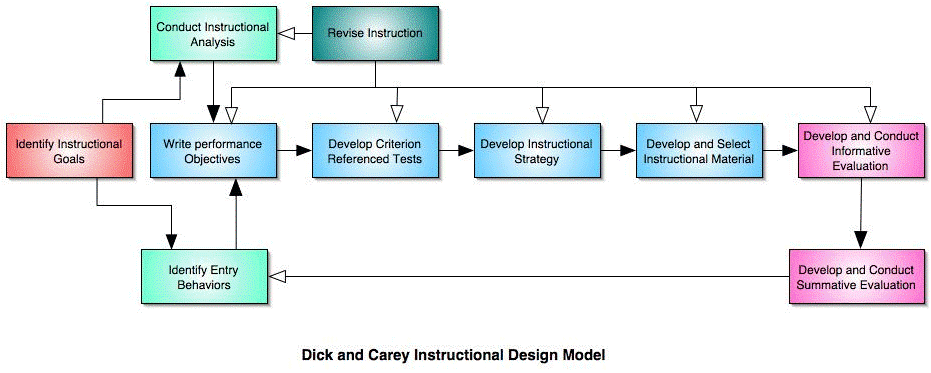
Dick, Cary, L., & Carey J (1978). The Dick and Carey Model – 1978. Retrieved from: https://www.google.com/search?q=dick+and+carrie+models&source=lnms&tbm=isch&sa=X&ved=2ahUKEwi1wtGSmLXrAhXtY98KHcnTBd8Q_AUoAXoECAwQAw&biw=1536&bih=763#imgrc=OqZeCkU_3H787M
Morrison, Ross, and Kemp Model (MRK), – consist of 9 interrelated steps, a linear approach that is interdependent (usually for 1-2 hours of instruction). It follows a circular structure rather than a linear structure. It provides more flexibility as any of the nine components can be used to begin the design process.

Instructional Strategies
Gagne’s Events of Instruction (Gaining attention, Informing the learner of the objectives, assessing, motivate, evaluate) Gagne’s instruction events address learning conditions and provide a foundation upon which online courses can be structured.
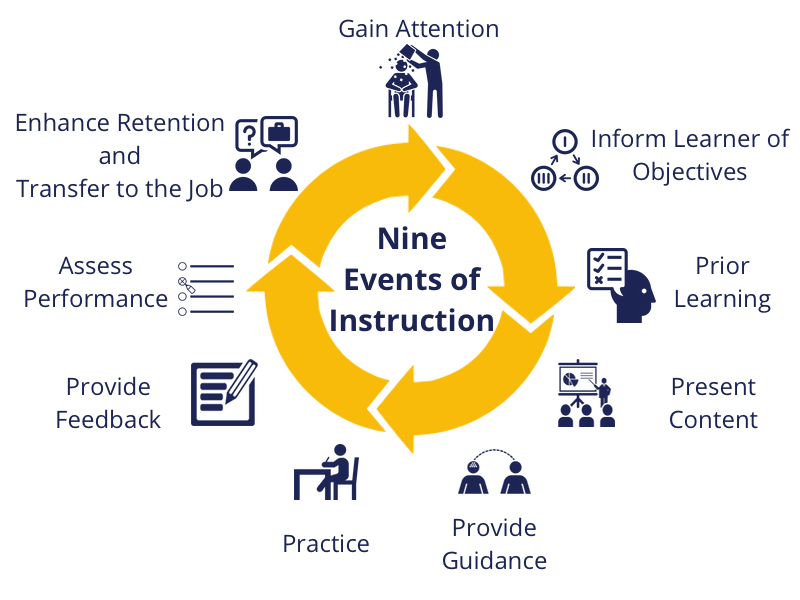
Bloom’s Taxonomy
Bloom’s taxonomy is a set of three hierarchical models used to classify educational learning objectives into complexity and specificity levels. The three lists cover the learning objectives in cognitive, affective, and sensory domains. The cognitive domain list has been the primary focus of most traditional education and is frequently used to structure curriculum learning objectives, assessments, and activities. The cognitive domain, which is frequently used, consists of six main categories. Based on the revised edition of 2001, it consists of categories (remember, understand, apply, analyze, evaluate, create) that can be used to structure the learning objectives, lessons, and course assessment
Source: Armstrong, P. (2016). Bloom’s taxonomy. Vanderbilt University Center for Teaching;
Sosniak, L. A. (1994). Bloom’s taxonomy. L. W. Anderson (Ed.). Chicago, IL: Univ. Chicago Press.
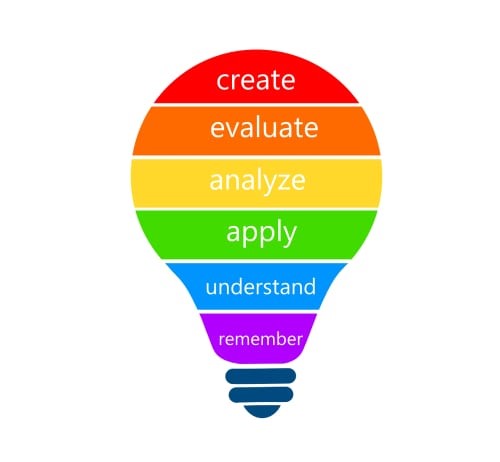
Training Today
Today we want information faster and cheaper (create once, use much time, reduce time-to-market, reduce cost, better allocation of resources, more for less)
Support learning 24 hours a day; support no longer needs to be a live person, but even self-study portal or community forums are an effective way of providing support.
Increase engagement, motivation, use of technology to engage learners of all ages.
Accelerate learning
Personalize learning; learners can access learning related to their role and requirement.
Technology Available
Collaboration, Feedback, Videos, Social Learning
Technology infuses classroom with digital learning tools
Different types used in school – Online learning, Full-time Online School, Blended Learning Approach, Open Resource
Growth in Open Source Technology
SaaS based subscription for LMS, LCMS & CMS
Technology moving to cloud
Challenges
Engage Learners (Meaningful engagement)
o Retain information and can use in a job is a meaningful engagement
Signs and symptoms of learner engagement
o Ask a purposeful question; challenges ideas collaborate with the team, think strategically
Encourage problem-solving activity, create problem-solving activity, decision making, investigation (examining and analyzing), reflective thinking Create Training Vs Design Training
Create Training
- Required elements, delivery formats, defined structures, development tools
- Design Training
- Instruction design, student insight, writer inference, intuition, aptitude, experience
Change Management
Change can bring fear but may be seen as an opportunity
Return on Investment is needed
Strategy first (plan infrastructure, defined rules of engagement, select tools and resource, implement the architecture)
Tactics last (convert legacy content, create new content, expand, increase customization)
Fundamentals of learning
Learning is not just cognitive (knowledge) in nature but also conative (skills) and affective (behavioral). More on Bloom’s Taxonomy:
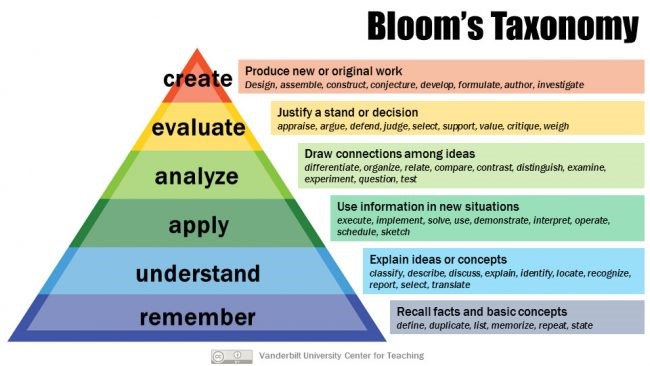
Source: Armstrong, P. (2016). Bloom’s taxonomy. Vanderbilt University Center for Teaching.
Elaboration on Bloom’s taxonomy
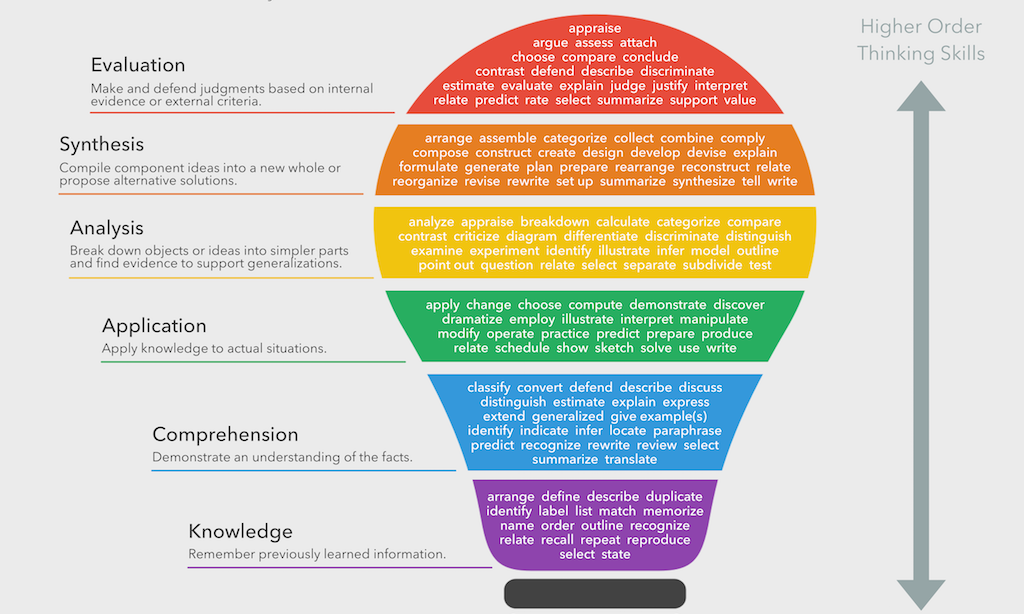
Source: Fractus Learning (2020) Blooms Taxonomy verbs. Retrieved from https://www.fractuslearning.com/blooms-taxonomy-verbs-free-chart/
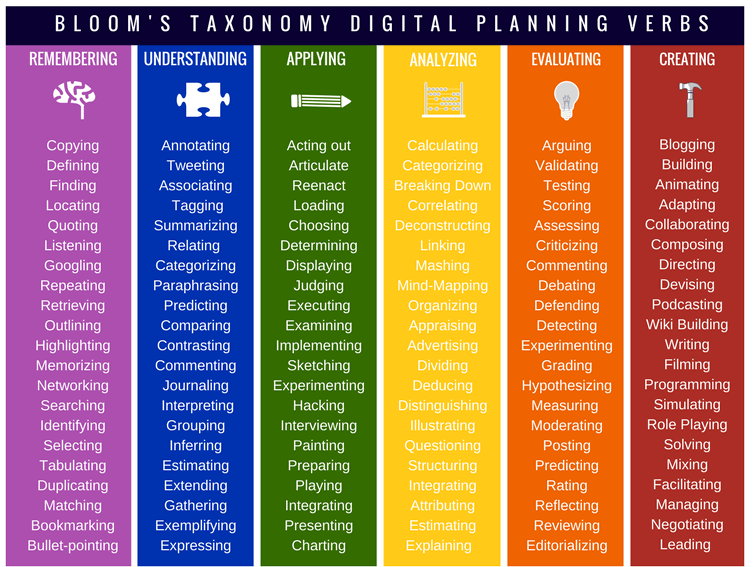
Source: Teachthought (2020, May 1). What is Bloom’s Taxonomy? A Definition for Teachers. Retrieved from https://www.teachthought.com/learning/what-is-blooms-taxonomy-a-definition-for-teachers/
Bottom line
Instructional methodologies have to foster these different learning types, and so, to state the apparent lecturing is not enough.
In class methods
In addition to lecture (traditional and through use of projector), case studies, brainstorming, discussion, role-playing, simulation exercise, debate, presentation by the student, and a team of students (teamwork); computer labs; and library searches including databases. Write up of personal views; critique
Online methods
Study, analysis, search and further analysis, discussion; teamwork; write up of personal views; critique
Instructional technologies: aim
To foster discovery learning, where to find relevant info and knowledge, how to analyze (use of big data tools)
Libraries
Play an important part in education
Have evolved over time mostly as a result of development of IT (Information Technologies)
Library traditional
Typical has printed material
Books
Journals
Magazines
Newspapers
Library modern
In addition to printed material the typical library has PCs with online access to the Internet (vast array of educational resources), online databases e.g. EBSCO, online analytical tools such as SPSS, SAS, online platforms such as Blackboard
Online databases https://www.google.com/search?source=hp&ei=oACNXLGtOoXn_QaJnaOgAQ&q=online+databases+for+research&oq=online+databases&gs_l=psy-ab.1.1.0l10.1073.5154..12080…0.0..0.196.1185.16j1……0….1..gws-wiz…..0..35i39j0i131.8iK3y8X0Vi8
Software
Proprietary
Open source
Useful tool
https://edu.google.com/openonline/
Virtual reality
VR has a major impact on education at all levels
State of the art: NYU virtual business library
Multimedia
Aim is to avoid the monotony of straight text and voice; a picture is worth more than a thousand words
They can be used both in-class and online:
eBooks
Videos
Video books
Movies
Games (powerful learning tool)
Optimal approach for the COVID 19 era
First we have to be more precise of our targets and target our approach as appropriate considering attention span::
-Pre-primary
-Primary-Grade 5
-Middle School Grade 8-8
-High School Grade 9-12
The following may be considered as elements of an appropriate approach:
-short videos
-movies
-games
-interactive exercises
-step by step searches
-use of electronic libraries
-students write their comments in particular expressing their views
-Q&A after each segment
The 10 Best Free Video Conferencing Tools to Choose From
- Zoom
- Google Hangouts
- UberConference
- TrueConf Online
- Skype
- FreeConference
- in
- Slack Video Calls
- Facebook Live
- YouTube Live
In conclusion
Education is as ‘exciting’ as it has ever been; it will continue to evolve more with technological developments.
More on educational technology:
Educational technology e-tech books
Annex 1: Dealing with an unprecedented situation; conducting learning in-class or online or hybrid
a) Hard numbers and school re opening
https://www.msn.com/en-us/news/technology/commentary-hard-numbers-should-dictate-school-reopenings/ar-BB186Her?ocid=msedgdhp
b) Case study: New York City Archdiocese deciding to go the traditional way
https://www.msn.com/en-us/news/us/nyc-catholic-schools-set-to-return-to-fully-in-person-classes-5-days-a-week/ar-BB188xQj?ocid=msedgdhp
c) Detailed plans of the schools in Summit, NJ
https://www.summit.k12.nj.us/uploaded/DISTRICT_FILES/Parent_Handbook.pdf
https://www.summit.k12.nj.us/uploaded/SHS_FILES/SHS_Opening_Handbook_Website.pdf
d) Round the world perspective
As students and teachers around the world return to class
https://www.msn.com/en-us/news/us/lessons-for-u-s-schools-as-students-and-teachers-around-the-world-return-to-class/vi-BB18AKD9?ocid=msedgdhp
Class time again across Europe
https://www.msn.com/en-us/news/world/it-s-class-time-again-across-europe-virus-or-no/ar-BB18AxC9?ocid=msedgdhp
e) Education – the new normal
https://www.oliverwyman.com/content/dam/oliver-wyman/v2/publications/2020/jun/Education_In_The_New_Normal.pdf
Annex 2: Resources
There is a vast amount of resources available online; the following sources are illustrative
Making videos
Making use of smart TVs
https://www.cnet.com/news/google-meet-comes-to-chromecast/
The video chat app is arriving on smart TVs this week, Google said.
Learning video collections for kids
https://www.youtube.com/watch?v=97wFth-uHVY
18 educational youtube channels for kids
https://www.chicagoparent.com/play/educational-youtube-channels-for-kids/
Educational games
10 Simple ways to make writing fun
https://medium.com/the-mission/10-simple-ways-to-make-writing-fun-1b53b426ac07
Blue School vast array of resources
Online learning for ages 2-8
Math Practice ages 5-15
Comprehensive curriculum



